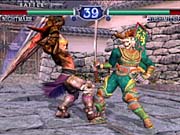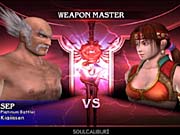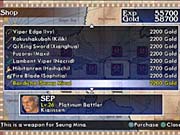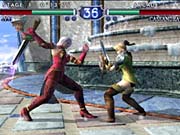By definition, one cannot improve upon perfection. So, considering that 1999's Soul Calibur for the Dreamcast is widely considered to be a flawless fighting game, maybe that explains why Namco didn't take many risks with the sequel, which has finally hit the PlayStation 2, Xbox, and GameCube. If you played and enjoyed the original Soul Calibur, chances are good that you'll also enjoy the sequel since it's so much like the first game. That also means Soul Calibur II won't impress you as much as its predecessor, since you've seen most of these characters, their weapons, and their moves before, and the available gameplay modes are nothing out of the ordinary. Nevertheless, on its own terms, Soul Calibur II is by all means a great fighting game, and Namco has done a fine job of making each respective console version equally enticing.

For the majority of players, the most significant difference between Soul Calibur II and its predecessor will be cosmetic, though the visuals haven't been overhauled completely. The returning characters all look different and the stages are all new, but many of the animations (even for some of the new characters) are recycled from the previous game, as is the flow and feel of a typical match. As before, gameplay involves four buttons, corresponding to your character's horizontal slash, vertical slash, kick, and guard. Using various combinations of these and the directional pad, you can make your characters unleash dozens of different moves. A number of the characters even have alternate fighting stances, which they can readily switch between to vary up their attacks.
There's a two-tiered rock-paper-scissors system here that's more or less identical to the system that worked so well in Soul Calibur: Low attacks hit high-blocking opponents, mid attacks hit low-blocking opponents, and high attacks tend to beat out mid attacks. Additionally, vertical slashes tend to have priority over horizontal slashes but can be dodged laterally, while horizontal slashes can counter an opponent who's sidestepping too often. Add in guard impact moves, which all characters can use to deflect their foes' attacks, and soul charge moves, which all characters can use to power up their attacks, and you've got a deep, tried-and-true combat system. The gameplay has been tweaked since Soul Calibur, to account for some of the issues that highly experienced players of the previous game picked up on. However, most players won't really notice the different properties of crouching or of lateral movement or things like that. Of further note, the game controls well using the default PS2, Xbox, and GameCube controllers. The PS2 controller is best suited, and the GameCube's directional pad is a little small, but all of these are responsive and more than serviceable with the game.
All of the Soul Calibur cast returns either in form or in spirit. From the samurai Mitsurugi to the undead pirate Cervantes, from the nunchaku-wielding Maxi to the female ninja Taki, from the bizarre Voldo to the aptly named Nightmare, most all the old favorites are intact, each with a smattering of new moves. Some have changed more than others, but for the most part, tactics and combos that worked well in Soul Calibur still work well here. There are a number of new characters in the game, though aside from the exclusive character in each console version of the game, only two characters are completely new: Raphael, a fencer whose feints and ripostes suitably capture the elegance and effectiveness of this fighting style, and Talim, a young girl whose speed and expertise with her twin blades make up for her small stature.
The special-guest characters in each version of the game are well done in their own right and are about as fully realized as the rest of the cast. The PlayStation 2 version gets the Tekken series' grizzled old karate master, Heihachi Mishima. The Xbox version gets Spawn, Todd McFarlane's muscle-bound comic book antihero. And the GameCube version gets none other than Link from The Legend of Zelda. These characters have been heavily promoted and talked about, and though none of them fits in very well with the rest of Soul Calibur II's characters, they each look good, are competitive, and have their own unique fighting styles. Heihachi has all the ferocious kicks and punches that make him a powerhouse in Tekken and looks better than ever before. Spawn has a limited ability to fly and can inflict massive damage with his ax. And Link's got all his classic moves and all his classic weapons, including the boomerang, the bow, and the bombs.

Another character is new to the home versions of Soul Calibur II and is not in the arcade original: Necrid, a Todd McFarlane creation specifically designed for this game. Necrid is surprisingly fast and powerful and fights with a ghostly weapon that mimics the other fighters' techniques. But this hunched-over, bloated action figure of a fighting game character seems like he was ripped out of some other game and thrown in here. Surely, it's great to have as many characters as possible in a fighting game. But there's also something to be said for having a cohesive look and style across all the characters. Each fighter in Soul Calibur for the Dreamcast, though remarkably different, at least looked like he or she belonged in the same game as all the other fighters in the lineup.
At any rate, the exclusive characters represent the biggest difference between the three console versions of Soul Calibur II, and if you're trying to decide on which version to get, you should probably go for the one with the character you'd most like to play as or against. Or if you have a home theater system and an Xbox, then the Xbox version is the way to go, since it features 720p HDTV support and Dolby Digital 5.1 sound. The other two versions are no slouches either, though, and natively support surround sound and widescreen progressive scan displays.
Another even more fortunate technical feature available in all three versions of the game is the option to switch from the default English language voice-over to the original Japanese. The game's announcer speaks fluent English no matter what and has some embarrassingly melodramatic lines to describe the fighters. However, many of the character voices, such as for Mitsurugi and Raphael, are much better in the Japanese language track, especially since some of the English translations are nonsensical. For example, Nightmare, a ferocious half-man possessed by the evil spirit contained in the sword known as Soul Edge, might viciously defeat his foe, only to declare: "Go away!"

Another aspect of Soul Calibur II that doesn't make much sense is the weapon master mode, which is sort of a half-glorified mission mode. The missions themselves are pretty good--you'll need to defeat your opponents while taking heed of certain conditions, such as maybe a dwindling health meter (you've been poisoned!) or gale-force winds that threaten to send either you or your opponent flying off the edge of the ring. In between missions, though, you'll get lots of long-winded text that details the mission mode's storyline. Something about a lengthy text-based story in a fighting game just doesn't feel right, especially in this day and age, and you'll probably end up skipping over the text just to get to (and through) the missions as quickly as possible. As you pass missions, you unlock some new modes of play and some not-so-hidden characters, and you also earn "gold" that can be used to "buy" new weapons for all the various fighters and some other unlockables.
The ability to acquire and use different weapons for each character is actually a throwback to the home version of Soul Calibur's predecessor, Soul Blade (also known as Soul Edge). The various weapons have special properties, perhaps having greater offensive power at the cost of some defensive power, or allowing the wielder to perform soul charges faster than normal. But these don't change the character's fighting style or anything, and, in keeping with the design theme of Soul Calibur II, they are mostly just graphical replacements. Still, having a variety of different weapons for each character along with unlockable art galleries, character profiles, alternate outfits, and other such things does give Soul Calibur II some good single-player lasting value. Too bad there's no online play, which quite possibly would have been the revolutionary step that Soul Calibur II needed to truly live up to its predecessor's legendary reputation.
Soul Calibur II's artificial intelligence is pretty good. At higher levels of difficulty, the computer delivers relentless competition, and it knows how to turn the tables in situations where it's getting close to being knocked out of the ring--though, in time, you'll probably pick up on some moves and patterns that the AI can't effectively contend with. Of course, fighting games are best when played against other human players of equivalent skill, and in these situations, Soul Calibur II can be just as entertaining as the previous installment in the series. The gameplay is as accessible as ever--just pick a fighter like Maxi or Kilik, and jam on the slash buttons to witness their impressive combat styles. Alternatively, you can hunker down and learn all the moves in a character's arsenal by going through the practice mode, which doesn't really teach you anything about how to play the game but at least lets you work on your moves.

This is a highly impressive game from a visual standpoint, no matter which version you get. Every once in a while, you might detect a very slight hitch in the frame rate (regardless of which version you're playing), but for the most part the game runs at a perfectly smooth 60 frames per second and features lifelike character models that have all been expertly motion captured. Of further note, though this is a weapon fighting game, don't expect to see any blood or dismemberment or anything, not that you would if you played Soul Calibur or its predecessor. At any rate, the Xbox version edges out the other two in terms of overall visual quality, but you might not notice except on a high-definition TV. The Xbox version also loads a bit faster in between matches, though the loading times are easily ignored in any of the versions. As mentioned, Soul Calibur II's English voice-over, enabled by default, is pretty spotty, though the Japanese is better. A grandiose soundtrack adds plenty of epic flair to the proceedings and is probably the strongest aspect of the audio. Most of the game's actual sound effects--sword slashes and such--are recycled from Soul Calibur, which were in turn recycled from Soul Blade.
If nothing else, Soul Calibur II is proof of how outstanding 1999's Soul Calibur really was. Like its predecessor, this sequel can provide countless hours of fast-paced, great looking battles--though if you played a lot of the previous Soul Calibur game, you'll be hard-pressed to sustain or even muster up the same level of enthusiasm over this update. That's not to say Soul Calibur II doesn't pack in any thrills of its own. It's certainly one of the most refined, most accessible, and best-looking 3D fighting games to date, and it's squarely the best game in its class for the Xbox and GameCube.